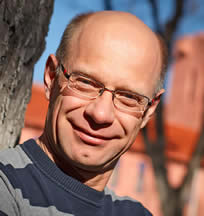Events
Surface-Plasmon Assisted Exciton and Charge Carrier Transport in One Dimensional Nanostructures
February 21, 2013 at 3pm/36-428
Andrei Piryatinski
Physics of Condensed Matter and Complex Systems Group, Los Alamos National Laboratory

Abstract:
The ability to precisely control optical and transport properties of nanostructured materials opens up possibility of their use as functional materials in a broad range of electronic and optoelectronic applications. Low-dimensional semiconductor materials (e.g., quantum dots, quantum wires, carbon nanotubes) posses electronic structures affected by the size-quantization allowing one to control light absorption/emission properties as well as the charge carriers and exciton transport. Metal nanoparticles also show tunable optical responses of the coherent charge oscillations called surface-plasmon modes. The nanoscale (near-field) interactions between confined carriers/excitons and surface-plasmons in the hybrid semiconductor-metal nanostructures leads to emergent physical properties.
This talk will discuss our theoretical study on charge carrier and exciton motion in one-dimensional semiconductor nanostructures (e.g., carbon nanotubes) in the presence of a localized surface-plasmon mode associated with a proximal metal nanoparticle. To treat the effect of the charge-surface-plasmon interactions, we use analogy with the polaron problem and calculate zero-point dynamical quantum correction to the charge-image potential. This leads to the formation of a tunneling barrier controlling the charge transmission through the one-dimensional nanostructure. Considering the exciton transport, we show that the problem maps on the problem of exciton scattering on an impurity state. Most interesting we demonstrate that the surface-plasmon resonance leads to the formation of a localized band-gap state. The emission properties of the exciton are affected by the interaction with the surface-plasmon mode. In particular, the localized state dramatically influences exciton-plasmon radiation pattern.
Bio:
Andrei Piryatinski earned his Ph.D. degree in physics and optical sciences from the University of Toledo in 1997 under Professor Robert T. Deck. He performed his postdoctoral training at the University of Rochester (1997-1999) in the group of Professor Shaul Mukamel and at the University of Wisconsin-Madison (1999-2002) in the group of Professor James Skinner. In 2002 he joined LANL as a CNLS postdoc and further became a Technical Staff Member in 2006. Dr. Piryatinski’s research covers ultrafast carriers dynamics in nanostructured semiconductors and metals materials, their optical and transport properties, and their ultrafast nonlinear spectroscopy. He also performed some work on nonadiabatic quantum and semiclassical dynamics in condensed molecular systems and vibrational dynamics is liquids.






